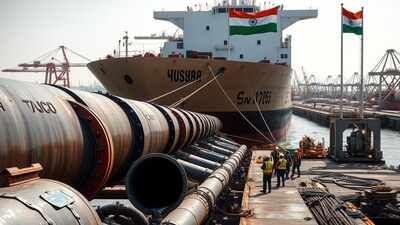Developer Offer
Try ImaginePro API with 50 Free Credits
Build and ship AI-powered visuals with Midjourney, Flux, and more — free credits refresh every month.
India Navigates Global Oil Shifts Amidst Tensions

Indian refiners are anticipated to buy 2 to 2.2 million barrels per day (bpd) of Russian crude oil in June, marking a two-year high. This strategic move comes as India, the world's third-largest oil importer and consumer, navigates market instability stemming from the Iran-Israel conflict. In June, India's total international crude oil acquisition stood at approximately 5.1 million barrels, which refineries process into fuels like petrol and diesel.
India's Strategic Pivot in Oil Procurement
Amidst the ongoing Iran-Israel conflict and the resultant market volatility, India has significantly ramped up its procurement of Russian oil. June's import volumes from Russia are set to exceed the combined purchases from traditional Middle Eastern suppliers like Saudi Arabia and Iraq. This shift underscores a deliberate strategy to ensure energy security rather than a reaction to panic.
According to preliminary analysis by Kpler, a global trade analytics firm, Indian refiners are on track to purchase between 2 and 2.2 million bpd of Russian crude in June. This not only represents a two-year peak but also surpasses the total quantities sourced from Iraq, Saudi Arabia, the UAE, and Kuwait combined.
Deep Dive: The Surge in Russian and US Oil Imports
India's oil procurement strategy has undergone a significant transformation, particularly after Russia's invasion of Ukraine in February 2022. Historically reliant on Middle Eastern supplies, India began importing substantial volumes of Russian oil, attracted by discounts offered due to Western sanctions and European boycotts.
Key figures highlight this trend:
- Russian oil imports to India reached 1.96 million bpd in May.
- American oil shipments to India are projected to increase to 439,000 bpd in June, a notable rise from 280,000 bpd the previous month.
- Conversely, Kpler's projections indicate that Middle Eastern imports for June will be approximately 2 million bpd, a decrease from previous acquisitions.
This shift has been dramatic, with Russian oil's share in India's total crude purchases soaring from under 1 per cent to about 40-44 per cent in a relatively short period. Sumit Ritolia, Lead Research Analyst at Kpler, emphasized the substantial changes in India's import approach. Russian oil varieties like Urals, ESPO, and Sokol bypass the Strait of Hormuz, using alternative routes such as the Suez Canal, Cape of Good Hope, or the Pacific Ocean. Indian refineries have adapted their refining and payment systems and enhanced operations to handle diverse crude options. While alternative sources from the US, West Africa, and Latin America are more expensive, they are increasingly viable.
Navigating Geopolitical Risks: The Strait of Hormuz Factor
The Iran-Israel war has heightened concerns about Middle East stability, although oil supply chains currently remain largely unaffected. Ritolia noted, "While supplies remain unaffected so far, vessel activity suggests a decline in crude loadings from the Middle East in the coming days. Shipowners are hesitant to send empty tankers (ballasters) into the Gulf, with the number of such vessels dropping from 69 to just 40, and (Middle East and Gulf) MEG-bound signals from the Gulf of Oman halving."
This anticipated constraint in MEG availability could compel India to adjust its procurement strategy further. The Strait of Hormuz, a critical chokepoint between Iran and Oman/UAE, is the primary channel for oil exports from Saudi Arabia, Iran, Iraq, Kuwait, and the UAE. It also handles significant Liquefied Natural Gas (LNG) transport, especially from Qatar.
With escalating military tensions, Iran has hinted at a possible closure of the Strait, which facilitates one-fifth of global oil movement and substantial LNG exports. For more details on this, see Iran-Israel conflict: India keeping tab on Chabahar Port, International North-South Transport Corridor; why it's important. India heavily relies on this route, with 40 per cent of its oil imports and half of its gas needs passing through it. Apprehensions about a Hormuz closure have grown following Israel's offensive actions.
Why a Full Blockade of Hormuz Remains Improbable
Despite Iranian hardline elements suggesting a closure and state media predicting oil prices could soar to $400 per barrel, Kpler's analysis assigns a very low probability to a full blockade. Ritolia stated, "Kpler analysis assigns a very low probability to a full blockade, citing strong disincentives for Iran."
Several factors make a self-imposed blockade counterproductive for Iran:
- China is Iran's primary oil customer, importing 47 per cent of seaborne crude from the Middle East Gulf via the Strait.
- Iran itself is heavily dependent on the Strait for its oil exports, with Kharg Island handling 96 per cent of its exports.
- Tehran has recently worked to restore diplomatic ties with regional powers like Saudi Arabia and the UAE, who rely on the Strait and oppose Israel's actions. Disrupting their oil flows would jeopardize these diplomatic gains.
- A blockade would likely trigger an international military response. US and allied forces could detect Iranian naval preparations, potentially leading to pre-emptive action. Kpler suggests even limited sabotage would only interrupt flows for 24-48 hours before US forces could neutralize Iran's naval capabilities. Further information can be found in Iran-Israel conflict: How will blocking of Strait of Hormuz hit India? Indian refiners look at alternative routes for fuel supply.
- Such actions would also strain relations with Oman, compromising Iran's communication channels with the US.
India's Multi-Layered Strategy for Energy Security
India's increased crude imports from Russia and the United States in June demonstrate a stability-focused approach. If the conflict deepens or Hormuz faces short-term disruptions, Russian barrels are poised to increase their share, offering both physical availability and pricing relief.
India has several contingency measures:
- It can increase reliance on the United States, Nigeria, Angola, and Brazil, despite higher transportation costs. More on related regional dynamics can be found here: India bleeds Pakistan dry: Water at ‘dead’ levels in Pakistan's dams; bigger Indus river plans in the works - top points to know.
- India can utilize its strategic reserves, covering approximately 9-10 days of imports.
- The government could implement price support measures to control inflation if domestic rates, particularly for diesel and LPG, rise.
From June 1st to 19th, Russian crude imports to India averaged 2.1-2.2 million bpd, maintaining Russia's position with over 35 per cent of India's total crude imports, a stable trend over the past 30 months. American crude imports during the same period were around 439,000 bpd, reflecting growing transatlantic trade and India's diversification strategy.
India's crude oil import strategy for June reflects a calculated, strategic approach rather than a panic response. Russian petroleum acts as a practical and economic buffer, complemented by supplies from the United States and the Atlantic Basin, which offer additional supply alternatives. While the Middle East remains significant, especially for crude and LPG, Indian refineries are now better equipped to address supply disruptions swiftly. The Strait of Hormuz continues to be a critical passage with low risk but potentially high impact, prompting India's refining industry to establish systems ensuring operational continuity, adaptability, and durability.
Compare Plans & Pricing
Find the plan that matches your workload and unlock full access to ImaginePro.
| Plan | Price | Highlights |
|---|---|---|
| Standard | $8 / month |
|
| Premium | $20 / month |
|
Need custom terms? Talk to us to tailor credits, rate limits, or deployment options.
View All Pricing Details

